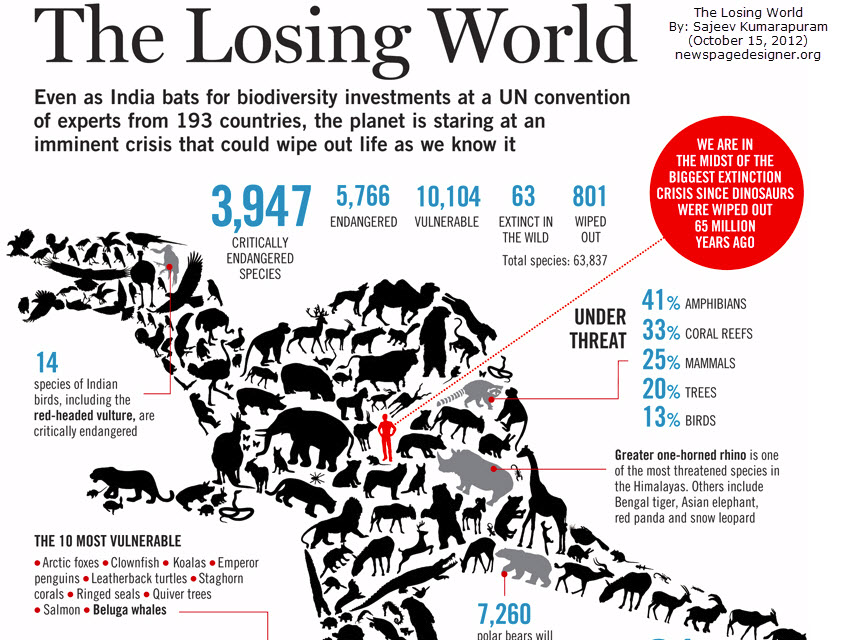Biodiversity estimations
 The newspapers are full of alarming headlines about loss of biodiversity, but what does this mean exactly? In this activity students explore species richness and evenness in different examples of field data. They use this data to calculate and to explain the Simpson's reciprocal diversity index. This could be a great opportunity for some real fieldwork, but if there is too little time, there is some data to analyse.
The newspapers are full of alarming headlines about loss of biodiversity, but what does this mean exactly? In this activity students explore species richness and evenness in different examples of field data. They use this data to calculate and to explain the Simpson's reciprocal diversity index. This could be a great opportunity for some real fieldwork, but if there is too little time, there is some data to analyse.
Lesson Description
Guiding Questions
Are the number of extinctions in the world increasing at the moment, or have there always been extinctions?
It very common that newspapers have alarming headlines about the risk to biodiversity. What does the word, "biodiversity" mean to,
- Journalists
- Ecologists
- Politicians?
Activity 1 - Species richness and biodiversity
Species richness and their evenness are both components of biodiversity. The greatest biodiversity is where there is a large number of species all of them in fairly large stable populations.
In the tropics the temperature is warm all year round and there is regular rainfall. Environmental stability helps populations remain stable.
Watch this short video about Biodiversity in the tropics ![]() Why do more species live near the equator?
Why do more species live near the equator?
Answer the following questions.
Questions
1. Give two reasons suggested in the film which could explain why there are more species near the equator.
.......................................................................................................
.......................................................................................................
2. The amount of life is not the same as diversity of life. Explain the difference
.......................................................................................................
.......................................................................................................
3. Species richness is the number of species, and "evenness" is the idea that all the species have an equal slice of the resources, so no one species dominates too much. Why do you think both of these concepts are important in measuring Biodiversity?
.......................................................................................................
.......................................................................................................
Activity 2 - Introduction to Simpson's diversity index
The Simpson's diversity index is a useful tool for ecologists as it takes into account the species richness and evenness.
The diversity (D) can be calculated using this equation.

N = total number of organisms of all species found and n = number of individuals of a particular species.
Read the information on the ![]() Simpson's diversity index introductory worksheet shown below and answer the questions.
Simpson's diversity index introductory worksheet shown below and answer the questions.
Activity 3 - Calculating Simpson's reciprocal diversity index from field data
Biogeographic factors affect species diversity and so it would make an excellent study to compare the diversity index of two similar areas which differ in either 'Patch size', 'Edge effect', or some other conservation factor,
Here are some examples;
- Plant species diversity before and after clearance of an invasive species in a local nature reserve,
- Invertebrate diversity before and after installation of an 'insect hotel'
- Diversity of pond invertebrates at different times of the year.
- Plant diversity on the school football pitch and in an adjacent area of grass.
Even if the students only measure the diversity on one occasion it will give them experience using Simpson’s reciprocal index of diversity. The following year students could repeat the measurement to compare biodiversity.
![]() Field experiment to collect data to use to calculate Simpsons diversity index
Field experiment to collect data to use to calculate Simpsons diversity index
Alternatively, use this ![]() Field experiment - example data from a moorland study in France as a data analysis exercise.
Field experiment - example data from a moorland study in France as a data analysis exercise.
Teacher's notes
Activity one introduced the concept of diversity, or biodiversity. It is a term which can have several meanings and the ecological meaning is the one which is needed here.
The video is a short introduction to the concept of variety in species rather than just the number of organisms in total
Activity 2 is a very straightforward introduction to the concepts of species richness and evenness leading to a diversity index. This leads on to activity 3.
Model answers for this activity are here: Simpsons diversity simple explainer - model answers
Student access to this page can be controlled by the teacher in the Student access section.
The last activity (3) is an example using real data from the field in order to analyse and calculate the Simpson's diversity index. Of course it would be better to collect data in the field to analyse, and if this is possible, then the sample data in activity three will help students to use a spreadsheet for the calculation of D.
Model answers for activity 3 can be found here: Simpson's diversity - field experiment - example data model answers
Student access to this page can be controlled by the teacher in the Student access section.

 IB Docs (2) Team
IB Docs (2) Team
